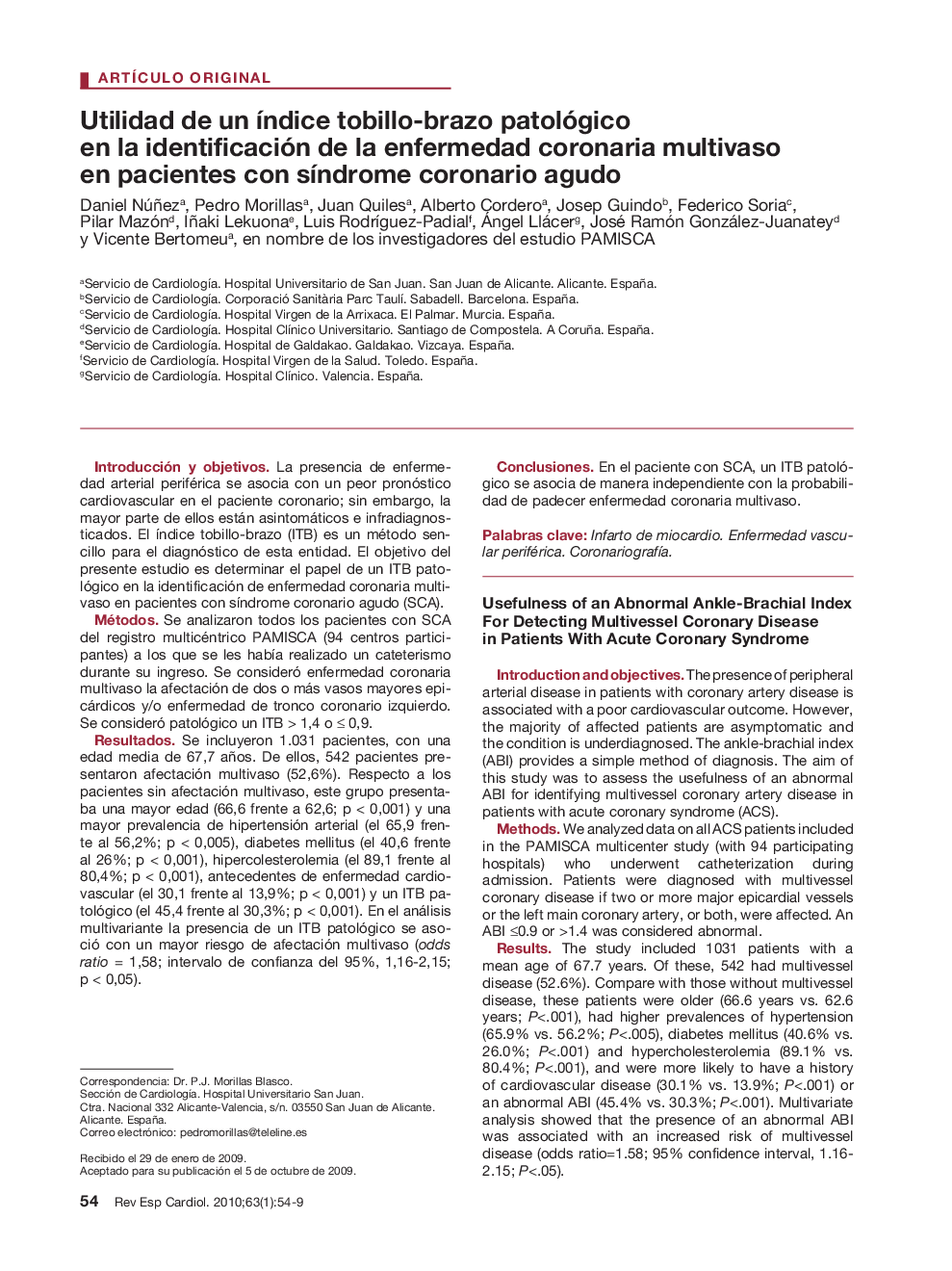| کد مقاله | کد نشریه | سال انتشار | مقاله انگلیسی | نسخه تمام متن |
|---|---|---|---|---|
| 3014235 | 1181883 | 2010 | 6 صفحه PDF | دانلود رایگان |

Introducción y objetivosLa presencia de enfermedad arterial periférica se asocia con un peor pronóstico cardiovascular en el paciente coronario; sin embargo, la mayor parte de ellos están asintomáticos e infradiagnosticados. El índice tobillo-brazo (ITB) es un método sencillo para el diagnóstico de esta entidad. El objetivo del presente estudio es determinar el papel de un ITB patológico en la identificación de enfermedad coronaria multivaso en pacientes con síndrome coronario agudo (SCA).MétodosSe analizaron todos los pacientes con SCA del registro multicéntrico PAMISCA (94 centros participantes) a los que se les había realizado un cateterismo durante su ingreso. Se consideró enfermedad coronaria multivaso la afectación de dos o más vasos mayores epicárdicos y/o enfermedad de tronco coronario izquierdo. Se consideró patológico un ITB > 1,4 o ≤ 0,9.ResultadosSe incluyeron 1.031 pacientes, con una edad media de 67,7 años. De ellos, 542 pacientes presentaron afectación multivaso (52,6%). Respecto a los pacientes sin afectación multivaso, este grupo presentaba una mayor edad (66,6 frente a 62,6; p < 0,001) y una mayor prevalencia de hipertensión arterial (el 65,9 frente al 56,2%; p < 0,005), diabetes mellitus (el 40,6 frente al 26%; p < 0,001), hipercolesterolemia (el 89,1 frente al 80,4%; p < 0,001), antecedentes de enfermedad cardiovascular (el 30,1 frente al 13,9%; p < 0,001) y un ITB patológico (el 45,4 frente al 30,3%; p < 0,001). En el análisis multivariante la presencia de un ITB patológico se asoció con un mayor riesgo de afectación multivaso (odds ratio = 1,58; intervalo de confianza del 95%, 1,16-2,15; p < 0,05).ConclusionesEn el paciente con SCA, un ITB patológico se asocia de manera independiente con la probabilidad de padecer enfermedad coronaria multivaso.
Introduction and objectivesThe presence of peripheral arterial disease in patients with coronary artery disease is associated with a poor cardiovascular outcome. However, the majority of affected patients are asymptomatic and the condition is underdiagnosed. The ankle-brachial index (ABI) provides a simple method of diagnosis. The aim of this study was to assess the usefulness of an abnormal ABI for identifying multivessel coronary artery disease in patients with acute coronary syndrome (ACS).MethodsWe analyzed data on all ACS patients included in the PAMISCA multicenter study (with 94 participating hospitals) who underwent catheterization during admission. Patients were diagnosed with multivessel coronary disease if two or more major epicardial vessels or the left main coronary artery, or both, were affected. An ABI ≤0.9 or >1.4 was considered abnormal.ResultsThe study included 1031 patients with a mean age of 67.7 years. Of these, 542 had multivessel disease (52.6%). Compare with those without multivessel disease, these patients were older (66.6 years vs. 62.6 years; P<.001), had higher prevalences of hypertension (65.9% vs. 56.2%; P<.005), diabetes mellitus (40.6% vs. 26.0%; P<.001) and hypercholesterolemia (89.1% vs. 80.4%; P<.001), and were more likely to have a history of cardiovascular disease (30.1% vs. 13.9%; P<.001) or an abnormal ABI (45.4% vs. 30.3%; P<.001). Multivariate analysis showed that the presence of an abnormal ABI was associated with an increased risk of multivessel disease (odds ratio=1.58; 95% confidence interval, 1.16-2.15; P<.05).ConclusionsIn patients with ACS, an abnormal ABI was independently associated with the risk of multivessel coronary artery disease.
Journal: Revista Española de Cardiología - Volume 63, Issue 1, January 2010, Pages 54–59